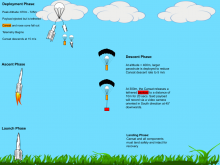UCI CanSat / AntSat
Background
Our CanSat for this year consists of 2 different parts, a science payload and its accompanying container. Initially, the CanSat is launched to an altitude of 670-725 meters where both the Payload and Container are deployed from the rocket near apogee. Here a small parachute deploys and the CanSat descends at a rate of 15 m/s until 400 meters, where a secondary larger parachute is deployed to reduce the descent rate to 5 m/s. After the Cansat reaches 300 meters, the CanSat releases a 10 meter-long tethered payload within 20 seconds. At this point, the payload will maintain video camera feed pitching 45 degrees downwards oriented in the south direction. During all portions of the mission, the payloads and container will record environmental data from onboard sensors and stream it in real time to a ground station computer.
Goals and Objectives
In addition to meeting our competition objectives, our team's goals are to provide all members with hands-on experience in engineering design. Although this goal has been more challenging to reach this year due to the hybrid environment, our team will try hard to adapt to the ever changing situation. Over the three quarters of the 2021-2022 academic year, we’ll go from brainstorming, to concept generation, to building and launching our flight hardware at the virtual CanSat competition live demonstration. We are a small team where every member has a critical part to play during the life-cycle of this multi-disciplinary engineering system.
Details on Progress
At this point in time, the team has successfully completed choosing out best two designs of the container and payload package after having each design go through a rigorous process of revision, preparation and presentation. The printed circuit boards (PCB’s) and electronic sensor selection has been set and are currently on their way to being ordered. The goal is to finish the Preliminary Design Review (PDR) as our first deliverable by the end of the quarter so the team could spend the remaining time practicing for the upcoming presentations and revising the designs. The electronics and software are currently in process of being made but are slated to be completed by the middle of winter quarter. For the remainder of the year, the team hopes to conduct multiple series of tests to ensure the CanSat is ready for competition by the end of Spring Quarter.
History
UCI CanSat was founded in 2017 and was the first team to represent UCI in the international CanSat Competition at Tarleton University. Historically UCI CanSat has placed very well and continues to do so. Below is a list of each year's placement.
2017-2018:
Preliminary Design Review Phase: 1/100
Critical Design Review Phase: 1/40
Overall: ?/20
2019-2020:
Preliminary Design Review Phase: 2/100
Overall: 11/40
2020-2021:
Preliminary Design Review Phase: 9/100
Critical Design Review Phase: 9/42
2021-2022
Preliminary Design Review Phase: TBA Feb 2021
Critical Design Review Phase: TBA May 2021
Post Design Review Phase: TBA June 2021
Sponsorships and Donations
UCI CanSat is always open to making sponsorship and donation connections to fund the construction of our project. If you are interested in sponsoring or donating to our UCI CanSat team, please contact us at cansatuci@gmail.com.
How to Join UCI CanSat
We are currently looking for Sophomore, Junior and Senior Mechanical, Aerospace, Computer, and/or Electrical engineers who may continue to work on the team next year as well. UCI students can contact cansatuci@gmail.com for information with a statement of interest and your resume.
Team Website
Please follow this link to our team website!
Team Contacts
UCI CanSat team, cansatuci@gmail.com
Advisor
Professor Roger Rangel, rhrangel@uci.edu

